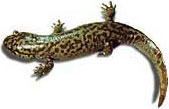|
Until
recently, the species in this family were lumped into the family Ambystomatidae.
David Good (1989) proposed that the species Dicamptodon ensatus
(which is the species described in Nussbaum et al. 1983) be split into
three species. The new species are D. tenebrosus, and
D. aterrimus. Representatives of this family are the
largest terrestrial salamanders in the Pacific Northwest. The species
found in Idaho, Dicamptodon aterrimus is the largest Idaho salamander.
Some differences that separate the family Dicamptodonitdae are less apparent
costal
grooves ,
and three segments in the fourth toe of the hind foot, as opposed to 4
segments (Stebbins 1985). Although not a useful distinguishing character,
the family Dicamptodontidae has an endemic ,
and three segments in the fourth toe of the hind foot, as opposed to 4
segments (Stebbins 1985). Although not a useful distinguishing character,
the family Dicamptodontidae has an endemic (Pacific Northwest) origin.
(Pacific Northwest) origin.
|
 |




